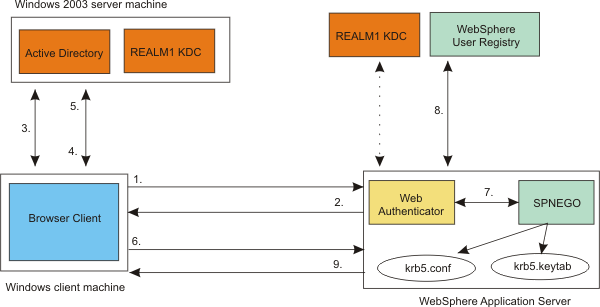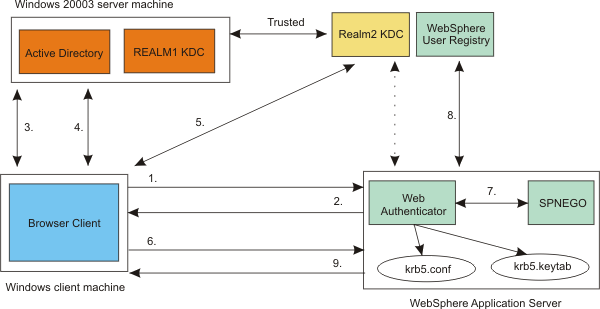Single sign-on for HTTP requests using SPNEGO web authentication
We can use Simple and Protected GSS-API Negotiation Mechanism (SPNEGO) as the web authentication service for WAS. We can enable either SPNEGO TAI (deprecated) or SPNEGO Web Authentication. Dynamic reload of SPNEGO is provided without the need to stop and restart WAS. Fallback to an application login method is provided if the SPNEGO web authentication fails. SPNEGO can be customized at the WebSphere security domain level. When WAS global and application security are enabled, and SPNEGO web authentication is enabled, SPNEGO is initialized when processing a first inbound HTTP request. The web authenticator component then interacts with SPNEGO, which is defined and enabled in the security configuration repository. When the filter criteria is met, SPNEGO is responsible for authenticating access to the secured resource identified in the HTTP request.
The benefits of having WAS use SPNEGO as the web authentication service for WAS include the following:
- (Windows) An integrated single sign-on environment with Microsoft Windows Servers using Active Directory domain is established.
- The cost of administering a large number of ids and passwords is reduced.
- A secure and mutually authenticated transmission of security credentials from the web browser or Microsoft .NET clients is established.
- Interoperability with web services and Microsoft .NET, or web service applications that use SPNEGO authentication at the transport level is achieved.
- With Kerberos authentication support, SPNEGO web authentication can provide an end-to-end SPNEGO to Kerberos solution and preserve the Kerberos credential from the client.
Required external components include:
- (Windows) Microsoft Windows Servers with Active Directory domain and associated Kerberos Key Distribution Center (KDC).
- A client application, for example, Microsoft .NET, or web service and J2EE client that supports the SPNEGO web authentication mechanism, as defined in IETF RFC 2478. The browser must be configured to use the SPNEGO web authentication mechanism.
The authentication of HTTP requests is triggered by the requestor (the client-side), which generates a SPNEGO token. WAS receives this token. The SPNEGO web authentication decodes and retrieves the requester's identity from the service SPNEGO token. The identity is used to establish a secure context between the requester and the application server.
SPNEGO web authentication is a server-side solution in WAS. Client-side applications are responsible for generating the SPNEGO token for use by SPNEGO web authentication. The requester's identity in the WAS security registry must be identical to the identity that the SPNEGO web authentication retrieves. An identical match does occur when Microsoft Windows Active Directory server is the LDAP server used in WAS. A custom login module is available as a plug-in to support custom mapping of the identity from the Active Directory to the WAS security registry.
WAS validates the identity against its security registry. If the validation is successful, the client Kerberos ticket and GSS delegation credential are retrieved and placed in the client subject, which then produces an LTPA security token. It then places and returns a cookie to the requester in the HTTP response. Subsequent HTTP requests from this same requester to access additional secured resources in WAS use the LTPA security token previously created to avoid repeated login challenges.
SPNEGO web authentication in a single Kerberos realm
SPNEGO web authentication is supported in a single Kerberos realm. The challenge-response handshake process is shown in the following figure:

In the previous figure, the following events occur:
- The client sends an HTTP/Post/Get/Web-Service request to WebSphere.
- WAS returns HTTP 401 Authenticate/Negotiate.
- The client obtains a Ticket Granting Ticket (TGT).
- The client requests a Service Ticket (TGS_REQ).
- The client obtains a Service Ticket (TGS_REP).
- The client sends HTTP/Post/Get/Web-Service and an authorization SPNEGO token to WebSphere.
- WAS validates the SPNEGO token. If the validation is successful, it retrieves the user ID and the GSS delegation credential from the service providerEGO token. Create a KRBAuthnToken with a client Kerberos credential.
- WAS validates the user ID with the WebSphere user registry and creates an LTPA token.
- WAS returns HTTP 200, content and the LTPA token to the client.
Other clients (for example, web services, .NET and J2EE) that support SPNEGO do not have to follow the challenge-response handshake process as shown previously. Those clients can obtain a ticket-granting ticket (TGT) and a Kerberos service ticket for the target server, create a SPNEGO token, insert it in the HTTP header, and then follow the normal process for creating an HTTP request.
SPNEGO web authentication in a trusted Kerberos realm
SPNEGO web authentication is also supported in a trusted Kerberos realm. The challenge-response handshake process is shown in the following figure:

In the previous figure, the following events occur:
- The client sends an HTTP/Post/Get/Web-Service request to WebSphere.
- WAS returns HTTP 401 Authenticate/Negotiate
- The client obtains a Ticket Granting Ticket (TGT).
- The client requests a cross realm ticket (TGS_REQ) for REALM2 from the REALM1 KDC.
- The client uses the cross-realm ticket from step 4 to request a Service Ticket from the REALM2 KDC.
- The client sends HTTP/Post/Get/Web-Service and an authorization SPNEGO token to WebSphere.
- WAS validates the SPNEGO token. If the validation is successful, it retrieves the user ID and the GSS delegation credential from the service providerEGO token. Create a KRBAuthnToken with a client Kerberos credential.
- WAS validates the user ID with the WebSphere user registry and creates an LTPA token.
- WAS returns HTTP 200, content and the LTPA token to the client.
In the trusted Kerberos realms environment, be aware of the following:
- The Kerberos trusted realm setup must be done on each of the Kerberos KDCs. See your Kerberos Administrator and User's guide for more information about how to set up Kerberos trusted realms.
- The Kerberos client principal name from the service providerEGO token might not exist in the WebSphere user registry; the Kerberos principal mapping to the WebSphere user registry might require it.
Support information for SPNEGO web authentication with a Java client using the HTTP protocol
The following scenarios are supported:
- Domain trust within the same forest
- External domain trust directly between domains within different forests.
- Kerberos realm trust
The following scenarios are not supported:
- Cross-forest trust
- Forest external trust
Support information for SPNEGO web authentication with a browser client
The following scenarios are supported:
- Cross-forest trusts
- Domain trust within the same forest
- Kerberos realm trust
The following scenarios are not supported:
- Forest external trusts
- Domain external trusts
Set up SPNEGO as the web authentication mechanism for WAS
Before we set up SPNEGO web authentication in the administrative console or using wsadmin commands, we must perform the steps as listed in Create a single sign-on for HTTP requests using SPNEGO Web authentication to set up SPNEGO web authentication for WAS.
SPNEGO web authentication on the server side must be done by the system administrator. The Kerberos krb5.keytab must be protected.